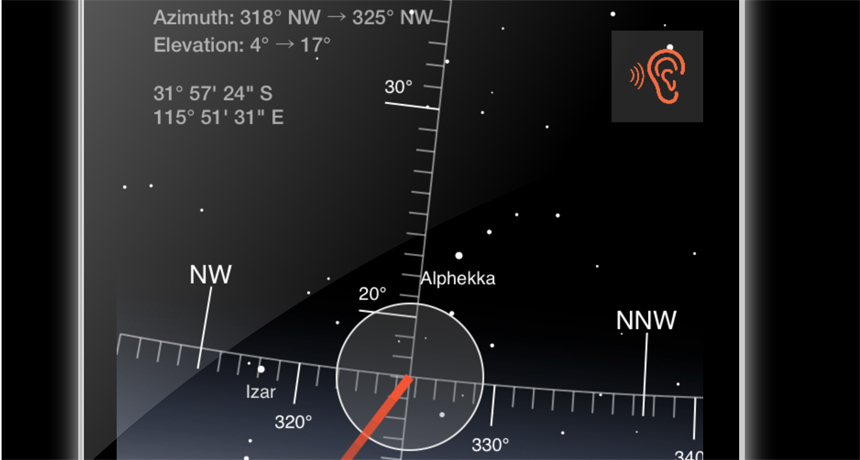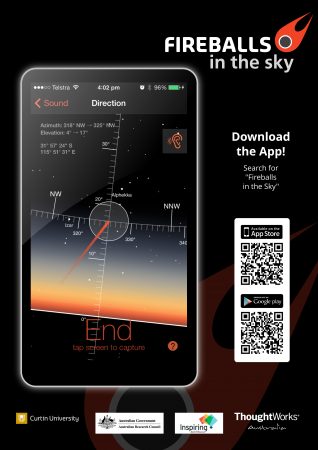Catch a ‘falling star’ with the smartphone in your pocket
A new free app helps you track meteors and contribute to science

“Fireballs in the sky,” a phone app shown here, lets citizens track the path meteors take.
Phil Bland/Curtin University
Share this:
- Share via email (Opens in new window) Email
- Click to share on Facebook (Opens in new window) Facebook
- Click to share on X (Opens in new window) X
- Click to share on Pinterest (Opens in new window) Pinterest
- Click to share on Reddit (Opens in new window) Reddit
- Share to Google Classroom (Opens in new window) Google Classroom
- Click to print (Opens in new window) Print
Have you ever seen a shooting star? Scientists hope you have and will see more. With your help — and a new smartphone app— you also can provide them potentially useful data.
“Shooting stars” aren’t really stars, churning mega-balls of super-hot gas. They are chunks of solid rock or metal hurtling through space. Any passing through Earth’s atmosphere will encounter so much friction that they will warm to glowing hot temperatures. From a distance, these white-hot visitors from space only look like falling stars trailed by glowing tails. Astronomers refer to the smaller pieces of incoming rock — ones that produce thin trails — as meteors. They call the bigger ones (producing very bright trails) fireballs.
This video describes the new “Fireballs in the sky” app and shows how you can report meteors as a citizen scientist.ThoughtWorks/YouTube |
Astronomers find all of these meteors — both big and small — enlightening. They can offer information about how the solar system formed. Some even give scientists clues about the origin of stars. That’s why scientists want to track meteors. If they know where they went, they might be able to collect them and see what they are made of. Now, you can help by reporting the apparent path of any meteor you see.
Phil Bland, a scientist at Curtin University in Perth, Australia, teamed up with Thoughtworks, a software maker to create “Fireballs in the sky.” They released this free smartphone app in October. It allows you to share information on any meteor you witness with a worldwide network. It will also share data from your sighting with others who also may have seen it. Scientists can use these data to map the object’s trajectory — where it came from and where it was going. Such information also can point them to where they might find a meteor’s remains, if it survived long enough to crash land.
“Fireballs in the sky” is a public outreach activity of the Desert Fireball Network. That network consists of cameras in the Australian desert that take pictures of the night sky. Together they provide a picture of the southern sky every 30 minutes. This allows scientists to track meteors.

The new app allows you to supplement those big-camera views. By tapping the eyes of the public throughout the globe, scientists hope to glean a lot more data. “I was really chuffed,” Bland says, “because there was a big fireball in Queensland (in the east of Australia), and someone with the app tracked it!”
To take part, just download the new app to your smartphone (it is compatible with iOS and Android devices). Then, the next time you see a shooting star, whip out that phone while you still remember the path the meteor had taken. Now, turn on the app and point it to where you first saw the meteor’s flash. Click once to record where in the sky you first saw the meteor appear. Click it once more to mark where it disappeared.
The app will then display a cartoon of the meteor it thought you saw. You can change its size and color, so that it better matches what you saw. Then send in your report. The app will then share a gallery of other meteor sightings. This will let you know if others saw your meteor.
The app is “engaging enough for pretty much anyone,” Bland says. It is definitely easy and fun. When I used the app, I got to see the meteors that other users had already recorded. I saw a bunch of other great photos too, from beautiful images of the night sky to a duck sitting on one of the sky recording cameras (oops).
If you’re interested in taking part in this program too, download the app from the Google Play store. Get ready to catch your own shooting stars for science!
Power Words
app Short for application, or a computer program designed for a specific task.
atmosphere The envelope of gases surrounding Earth or another planet.
fireball A lump of rock or metal from space that hits the atmosphere of Earth. Fireballs are meteors that are exceptionally bright and large.
friction The resistance that one surface or object encounters when moving over or through another. Friction generally causes a heating, which can damage the surface of the materials rubbing against one another.
meteor A lump of rock or metal from space that hits the atmosphere of Earth. In space it is known as a meteoroid. When you see it in the sky it is a meteor. And when it hits the ground it is called a meteorite.
Queensland One of the states that makes up the northeast corner of the country of Australia.
smartphone A cell (or mobile) phone that can perform a host of functions, including search for information on the Internet.
trajectory The path taken by a projectile moving through space and time, or the direction that a trend is taking over time.